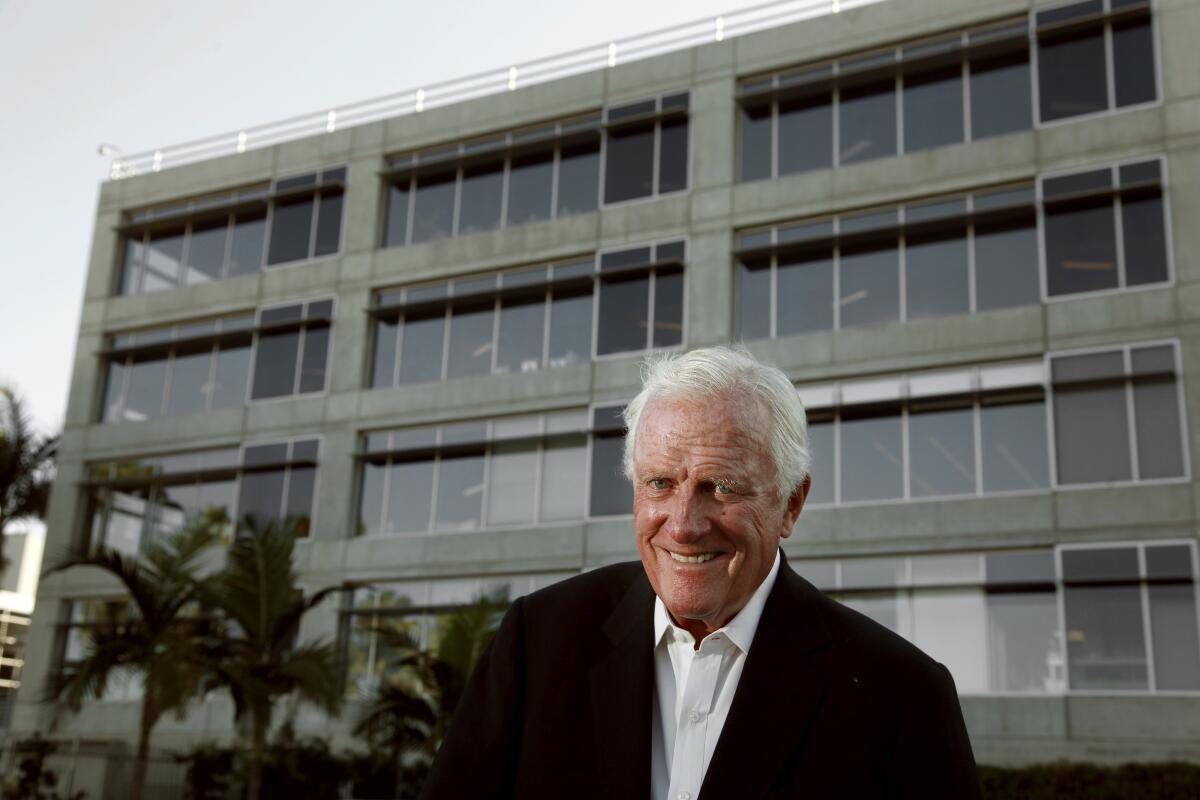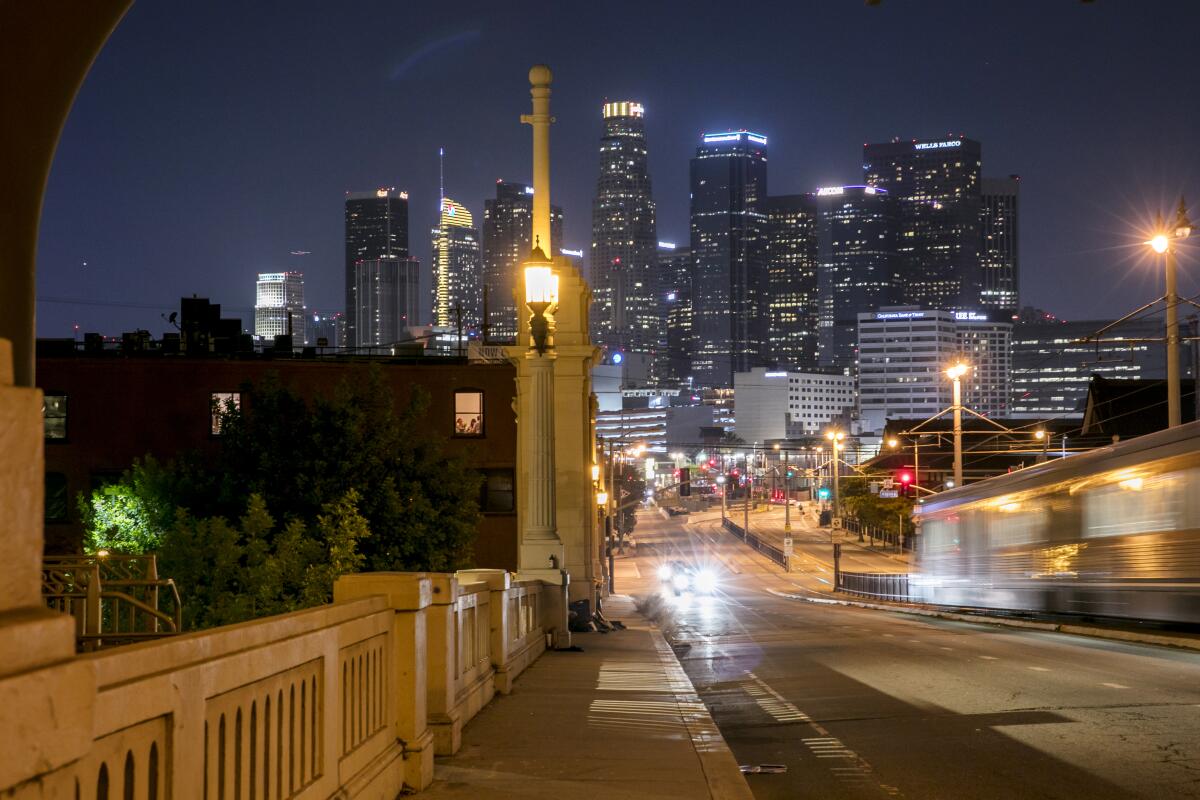Robert F. Maguire III, prominent developer who changed the L.A. skyline, dies

- Share via
Robert F. Maguire III, who changed the Los Angeles skyline as the developer of prominent high-rises including downtown icon U.S. Bank Tower, has died at his home in Studio City.
Maguire died Tuesday from complications from pneumonia, a family representative said. He was 86.
As a dominating figure in Southern California real estate during the commercial building boom of the 1980s and 1990s, Maguire used his clout to help save Los Angeles’ historic Central Library from demolition and was a civic leader who helped expand the Los Angeles County Museum of Art campus and stabilize its finances.
Maguire was born in Portland, Ore., on April 18, 1935, to a family with a high profile in public service. His grandfather, Robert F. Maguire, served as a judge in the Nuremberg trials held after World War II to bring accused Nazi war criminals to justice.
His pilot father, Robert F. Maguire Jr., helped evacuate 50,000 Jewish refugees from Yemen to Israel in an airlift between 1948 and 1950 and was reportedly called the Irish Moses by David Ben-Gurion, Israel’s first prime minister.
“I often accompanied my dad and his 28 other pilots on these 20-hour round-trip journeys,” Maguire said. “It was a great adventure for me. In addition, these guys taught me to fly at 13.”
Maguire graduated from UCLA in 1960 and went to work at Security Pacific National Bank, where he worked with large corporations and real estate developers before deciding to enter the real estate field on his own in 1965. His firm developed industrial and housing projects, then ventured into building the office towers he would become known for when he erected the high-rise Northrop Building in Century City in 1968.
During the 1970s, his company developed Peter’s Landing, a waterfront 40-acre commercial residential development in Huntington Beach, and rehabilitated a 1920s office building in downtown Los Angeles into senior housing.
After that, “he wanted a high-rise office building in downtown L.A.,” said Jim Thomas, who joined Maguire in the early 1980s to form Maguire Thomas Partners, which would go on to become one of the largest office developers in the country.
In the early 1980s, though, the city’s redevelopment agency was trying to steer developers to Bunker Hill, Thomas said, but “a number of developers had tried and failed” to get projects going on empty land there. “It was a graveyard” for builders.
Maguire plowed ahead, Thomas said, and was able to secure tenants and financing to build what is now Wells Fargo Center, an office complex on Grand Avenue with a pair of granite-clad skyscrapers containing 2.5 million square feet that quickly became one of the best business addresses in the city.
Maguire and his team hoped to follow that up with another major office complex across Grand Avenue, but lost out when the city selected another developer to build what is now California Plaza.
“We took that loss — especially Rob — very hard,” Thomas said. “It bothered him for years.”

The firm would bounce back downtown with what became Maguire’s most high-profile achievement, the creation of what was once the tallest skyscraper in the West at 73 stories now known as U.S. Bank Tower in 1989 and another skyscraper nearby called Gas Company Tower in 1991.
The buildings were part of a plan Maguire helped develop to help save Central Library, which opened in 1926 and was in danger of demolition because it was obsolete and then badly damaged in an arson fire in 1986.
Key to saving the library was Maguire Thomas’ purchase of the library’s “air rights” to build higher than its existing height if it so desired. By buying those rights from the library, Maguire secured permission to build the two skyscrapers to the heights he wanted and the library received more than $125 million to help fund an expansion and repairs.
“Rob always wanted his projects to be significant in and of themselves, but also significant to the community,” said Ned Fox, former president of Maguire Thomas, who remembers Maguire as energetic and demanding.
“When you were working on a project with Rob, he was always instigating and agitating new ideas to make it better.”
Maguire’s firm went on to develop in other cities, including Glendale, Santa Monica, Philadelphia, Dallas and Pasadena, where his firm built the Plaza Las Fuentes office and hotel complex.
As the volunteer president of the Los Angeles County Museum of Art, Maguire helped stabilize its finances by crafting a deal with county officials to make fixed annual payments to the museum instead of negotiating for their support every year. He also expanded the LACMA campus by convincing the county and museum board to purchase the adjacent eight-acre May Company site at a price he negotiated.
The Academy Museum of Motion Pictures agreed to lease the former department store from LACMA in 20`14 and is adapting it for its new museum.
Thomas and Maguire parted ways in 1996 when the company was attempting to develop a movie studio for DreamWorks SKG in Playa Vista, a plan DreamWorks abandoned in 1999. Other developers went on to build Playa Vista as a planned community.
Fox called Maguire “a confident risk taker,” which was apparent when he took his real estate company Maguire Properties public in 2003 and proceeded to grow at a heady pace as its stock price climbed.
“Rob was never content with being less than big size-wise and he wanted to expand,” said Rick Gilchrist, a former co-chief executive in the company. “He was a big-hearted person and could be tough as nails. He absolutely wouldn’t quit.”
Maguire apparently expanded too fast, betting heavily in 2007 when he led a $3-billion acquisition of 24 office buildings in Orange and Los Angeles counties. Borrowing money for the heavily leveraged purchase was fairly easy at the time, when capital markets were still flush with cash.
Soon the economy turned, leaving Maguire and other landlords to struggle with high vacancy and falling rents.
“Most of his risks paid off, but that one didn’t,” said Gilchrist, who described Maguire as the kind of “swashbuckler” found in the real estate industry before it became more staid and corporate in recent decades.
Maguire left his company in May 2008 and its buildings were eventually sold.
Maguire continued to develop real estate, most recently an office building at Water’s Edge in Playa Vista intended to appeal to creative companies with different tastes than the blue chip firms that populated Bunker Hill as Maguire endeavored to change with the times.
“Smart companies want innovative space,” he said in 2014. “Conventional office space is going to have a hard time competing.”
Maguire will best be recalled for helping make Los Angeles look like a big city, though, Thomas said.
“For those of us who were there when it happened,” he said, “you can’t look at the skyline of downtown L.A. without remembering Rob.”
More to Read
Inside the business of entertainment
The Wide Shot brings you news, analysis and insights on everything from streaming wars to production — and what it all means for the future.
You may occasionally receive promotional content from the Los Angeles Times.











